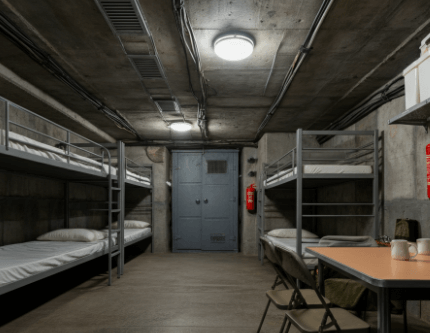Building a secure shelter is a top priority for many, but the Sunshine State’s unique environment poses major challenges. Learning how to build an underground bunker in Florida requires careful planning due to high water tables, which are often just a few feet below the surface in coastal counties. Issues such as sandy soil, hurricane wind codes reaching up to 180 mph, and FEMA flood maps make below-ground construction extremely complex. Any project must address groundwater intrusion with extensive waterproofing, powerful sump pumps, and corrosion-resistant materials to succeed. Understanding these obstacles is the first step to determining if your land is suitable for a bunker. Steve Daria and Joleigh, distinguished real estate investors and cash land buyers, bring their expertise to evaluating properties that present complex building requirements. They can help you assess your lot’s potential or provide a fast, as-is purchase if the site proves unworkable. If you’re wondering how to build an underground bunker in Florida and need expert guidance on your land, book a free, no-obligation discussion with Steve Daria and Joleigh today.
What is an Underground Bunker?
Before learning how to build an underground bunker in Florida, it’s essential to understand that an underground bunker serves as a fortified sanctuary constructed beneath the earth’s surface to shield occupants from a range of potential threats.
These can involve natural disasters like hurricanes, tornadoes, earthquakes, and floods, which pose immediate dangers to above-ground structures.
Additionally, bunkers are designed to withstand man-made risks such as nuclear fallout, biological hazards, or civil unrest, providing a secure environment in times of crisis.

Why Build an Underground Bunker in Florida?
Building an underground bunker in Florida offers several compelling reasons, primarily driven by the state’s geographical and climatic characteristics.
Florida’s frequent exposure to hurricanes and tropical storms necessitates robust preparedness strategies, and an underground bunker provides a secure refuge against these powerful natural disasters.
The state’s flat terrain and susceptibility to flooding during hurricanes further underscore the importance of having a shelter that is not vulnerable to storm surges or wind damage.
Key Features of a Modern Bunker
Modern bunkers come with a range of features designed to ensure safety and comfort:
- Reinforced Walls: Typically made from concrete and steel to withstand extreme conditions.
- Ventilation Systems: Essential for air circulation and preventing mold and mildew.
- Water and Waste Management: Systems to ensure clean water supply and waste disposal.
- Storage: Ample space for food, supplies, and personal belongings.
Get Started: Get Your Cash Offer Below…
We are direct land buyers. There are no commissions or fees and no obligation whatsoever. Start below by sharing where your property is and where we can send your offer…
How to Build an Underground Bunker in Florida: Planning Stage
Planning is the first essential step in building an underground bunker.
Assessing Your Needs
Before you start construction, it’s crucial to assess your specific needs.
Consider the following questions:
- What is the primary purpose of your bunker? (e.g., storm shelter, long-term survival, storage)
- How many people will it need to accommodate?
- What duration of stay are you planning for?
Choosing the Right Location
The location of your bunker is critical to its effectiveness.
Here are some tips for selecting the ideal spot:
- Elevation: Choose a location that is not prone to flooding.
- Accessibility: Ensure easy access while maintaining a level of discretion.
- Land Stability: Conduct soil tests to ensure the ground can support the structure.
Legal Considerations
Building an underground bunker involves navigating various legal requirements. These include:
- Building Permits: Obtain the necessary permits from local authorities.
- Zoning Laws: Ensure your property is zoned for such structures.
- Safety Codes: Adhere to local building codes and safety regulations.
How to Build an Underground Bunker in Florida: Design and Construction
The second step is designing and constructing your underground bunker
Hiring a Professional vs. DIY
When contemplating the construction of an underground bunker in Florida, the decision between DIY and hiring a professional involves critical considerations.
While a DIY approach may seem cost-effective initially, building an underground bunker requires specialized knowledge of structural engineering, geology, and construction techniques specific to underground environments.
Professionals bring years of experience in handling the complexities involved, such as soil composition analysis, waterproofing, ventilation systems, and ensuring structural integrity against potential hazards like flooding or soil erosion.
Structural Design
A well-designed bunker should include:
- Foundation: A strong foundation to prevent collapse.
- Walls and Roof: Reinforced concrete walls and a sturdy roof.
- Entrance and Exits: Secure, easily accessible entry and exit points.
Installing Essential Systems
To make your bunker livable, you’ll need to install several essential systems:
- Ventilation: A reliable ventilation system to maintain air quality.
- Electrical Systems: Backup generators and battery systems for power.
- Plumbing: Water storage and waste management systems.
How to Build an Underground Bunker in Florida: Enhancing Your Bunker
The third essential step is enhancing your bunker.
Safety Features
Enhance the safety of your bunker with features such as:
- Surveillance Systems: Cameras and motion detectors to monitor the surroundings.
- Fire Safety: Fire extinguishers and smoke detectors.
- Emergency Supplies: Stockpile of food, medical supplies, and tools.
Comfort and Livability
Ensure your bunker is comfortable for extended stays by including:
- Furniture: Bunk beds, seating areas, and workspaces.
- Climate Control: Heating and cooling systems.
- Entertainment: Books, games, and other ways of entertainment.
Customization Options
Personalize your bunker to suit your preferences:
- Interior Decor: Choose colors and materials that make the space inviting.
- Additional Rooms: Consider adding a kitchen, bathroom, or storage room.
- Tech Integration: Install Wi-Fi, communication systems, and other technology.
How to Build an Underground Bunker in Florida: Cost and Maintenance
Considering the cost and maintenance of building your underground bunker is crucial.
Budgeting for Your Bunker
Building an underground bunker involves significant investment.
Here’s a rough breakdown of costs:
- Design and Permits: $5,000 – $15,000
- Construction: $50,000 – $100,000
- Systems Installation: $20,000 – $40,000
- Furnishing and Supplies: $10,000 – $30,000

Financing Options
Explore various financing options, such as:
- Loans: Home improvement loans or personal loans.
- Savings: Using personal savings to make the project.
- Grants: Research potential grants for disaster preparedness.
Regular Maintenance
Ensure your bunker remains functional with regular maintenance:
- Inspections: Routine checks for structural integrity and systems performance.
- Repairs: Address any issues promptly to avoid larger problems.
- Updates: Keep emergency supplies and equipment up-to-date.
Takeaway
- Environmental Challenges: Recognize that Florida’s high water table and sandy soil are the biggest obstacles, making below-ground construction extremely challenging. These environmental factors require specialized engineering to prevent structural collapse and water intrusion, complicating any plans for a subterranean shelter.
- Regulatory Requirements: Before any project begins, consult FEMA flood maps and local county building codes; these regulations are essential as they define where and how construction is permitted. Understanding these rules is the first step toward legally and safely building an underground bunker in Florida.
- Structural Integrity: Prioritize structural integrity by designing for hurricane-force wind loads and ensuring proper ventilation and emergency egress points are included. Florida’s strict building codes require your bunker to withstand extreme weather events above and below ground.
- Waterproofing and Drainage: Invest heavily in waterproofing, drainage systems like sump pumps, and corrosion-resistant materials to combat constant moisture. Without these critical protections, groundwater will inevitably compromise the structure, leading to leaks, mold, and eventual failure.
- Feasibility Assessment: Evaluate whether your property is even suitable, as the high costs and engineering complexities can make some sites unworkable. If you need help determining feasibility or have land that won’t work, consulting an expert is a wise move for anyone learning how to build an underground bunker in Florida.
**NOTICE: Please note that the content presented in this post is intended solely for informational and educational purposes. It should not be construed as legal or financial advice or relied upon as a replacement for consultation with a qualified attorney or CPA. For specific guidance on legal or financial matters, readers are encouraged to seek professional assistance from an attorney, CPA, or other appropriate professional regarding the subject matter.
